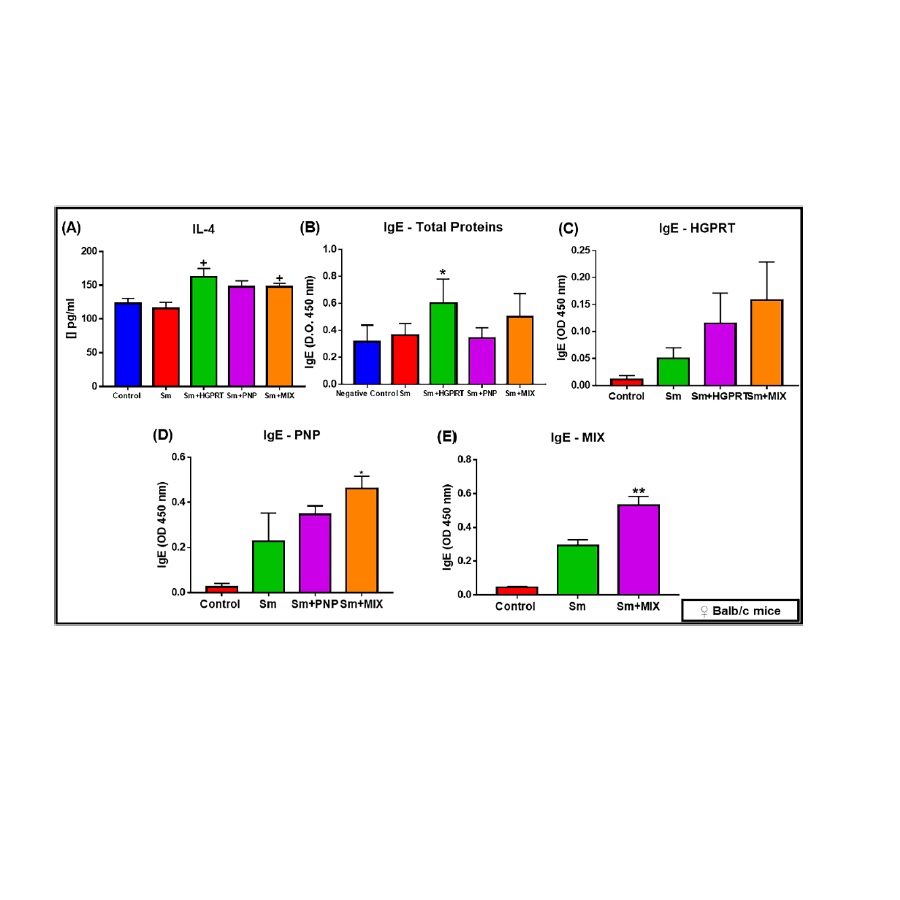HGPRT and PNP: recombinant enzymes from Schistosoma mansoni and their role in immunotherapy during experimental murine schistosomiasis.
FRAGELLI, Bruna Dias de Lima; FATTORI, Ana Carolina Maragno; MONTIJA, Elisandra de Almeida; RODOLPHO, Joice Margareth de Almeida; CASTRO, Cynthia Aparecida de; GODOY, Krissia Franco de; NOGUEIRA, Camila Tita; RODRIGUES, Vanderlei; SOARES, Edson Garcia; ROMANELLO, Larissa; OLIVEIRA, Juliana Roberta Torini de Souza; PEREIRA, Humberto d'Muniz; ANÍBAL, Fernanda de Freitas.
FRAGELLI, Bruna Dias de Lima; FATTORI, Ana Carolina Maragno; MONTIJA, Elisandra de Almeida; RODOLPHO, Joice Margareth de Almeida; CASTRO, Cynthia Aparecida de; GODOY, Krissia Franco de; NOGUEIRA, Camila Tita; RODRIGUES, Vanderlei; SOARES, Edson Garcia; ROMANELLO, Larissa; OLIVEIRA, Juliana Roberta Torini de Souza; PEREIRA, Humberto d'Muniz; ANÍBAL, Fernanda de Freitas.




 Abstract: Schistosomiasis is a parasitic infection caused by trematode worms (also called blood flukes) of the genus Schistosoma sp., which affects over 230 million people worldwide, causing 200,000 deaths annually. There is no vaccine or new drugs available, which represents a worrying aspect, since there is loss of sensitivity of the parasite to the medication recommended by the World Health Organization, Praziquantel. The present study evaluated the effects of the recombinant enzymes of S. mansoni Hypoxanthine-Guanine Phosphoribosyltransferase (HGPRT), Purine Nucleoside Phosphorylase (PNP) and the MIX of both enzymes in the immunotherapy of schistosomiasis in murine model. These enzymes are part of the purine salvage pathway, the only metabolic pathway present in the parasite for this purpose, being essential for the synthesis of DNA and RNA. Female mice of Swiss and BALB/c strains were infected with cercariae and treated, intraperitoneally, with three doses of 100 µg of enzymes. After the immunotherapy, the eggs and adult worms were counted in the feces; the number of eosinophils from the fluid in the peritoneal cavity and peripheral blood was observed; and the quantification of the cytokine IL-4 and the production of antibodies IgE was analyzed. The evaluation of the number of granulomas and collagen deposition via histological slides of the liver was performed. The results demonstrate that immunotherapy with the enzyme HGPRT seems to stimulate the production of IL-4 and promoted a significant reduction of granulomas in the liver in treated animals. The treatment with the enzyme PNP and the MIX was able to reduce the number of worms in the liver and in the mesenteric vessels of the intestine, to reduce the number of eggs in the feces and to negatively modulate the number of eosinophils. Therefore, immunotherapy with the recombinant enzymes of S. mansoni HGPRT and PNP might contribute to the control and reduction of the pathophysiological aspects of schistosomiasis, helping to decrease the morbidity associated with the infection in murine model.
Abstract: Schistosomiasis is a parasitic infection caused by trematode worms (also called blood flukes) of the genus Schistosoma sp., which affects over 230 million people worldwide, causing 200,000 deaths annually. There is no vaccine or new drugs available, which represents a worrying aspect, since there is loss of sensitivity of the parasite to the medication recommended by the World Health Organization, Praziquantel. The present study evaluated the effects of the recombinant enzymes of S. mansoni Hypoxanthine-Guanine Phosphoribosyltransferase (HGPRT), Purine Nucleoside Phosphorylase (PNP) and the MIX of both enzymes in the immunotherapy of schistosomiasis in murine model. These enzymes are part of the purine salvage pathway, the only metabolic pathway present in the parasite for this purpose, being essential for the synthesis of DNA and RNA. Female mice of Swiss and BALB/c strains were infected with cercariae and treated, intraperitoneally, with three doses of 100 µg of enzymes. After the immunotherapy, the eggs and adult worms were counted in the feces; the number of eosinophils from the fluid in the peritoneal cavity and peripheral blood was observed; and the quantification of the cytokine IL-4 and the production of antibodies IgE was analyzed. The evaluation of the number of granulomas and collagen deposition via histological slides of the liver was performed. The results demonstrate that immunotherapy with the enzyme HGPRT seems to stimulate the production of IL-4 and promoted a significant reduction of granulomas in the liver in treated animals. The treatment with the enzyme PNP and the MIX was able to reduce the number of worms in the liver and in the mesenteric vessels of the intestine, to reduce the number of eggs in the feces and to negatively modulate the number of eosinophils. Therefore, immunotherapy with the recombinant enzymes of S. mansoni HGPRT and PNP might contribute to the control and reduction of the pathophysiological aspects of schistosomiasis, helping to decrease the morbidity associated with the infection in murine model. @article={003128055,author = {FRAGELLI, Bruna Dias de Lima; FATTORI, Ana Carolina Maragno; MONTIJA, Elisandra de Almeida; RODOLPHO, Joice Margareth de Almeida; CASTRO, Cynthia Aparecida de; GODOY, Krissia Franco de; NOGUEIRA, Camila Tita; RODRIGUES, Vanderlei; SOARES, Edson Garcia; ROMANELLO, Larissa; OLIVEIRA, Juliana Roberta Torini de Souza; PEREIRA, Humberto d'Muniz; ANÍBAL, Fernanda de Freitas.},title={HGPRT and PNP: recombinant enzymes from Schistosoma mansoni and their role in immunotherapy during experimental murine schistosomiasis},journal={Pathogens},note={v. 12, n. 4, p. 527-1-527-14},year={2020}}
@article={003128055,author = {FRAGELLI, Bruna Dias de Lima; FATTORI, Ana Carolina Maragno; MONTIJA, Elisandra de Almeida; RODOLPHO, Joice Margareth de Almeida; CASTRO, Cynthia Aparecida de; GODOY, Krissia Franco de; NOGUEIRA, Camila Tita; RODRIGUES, Vanderlei; SOARES, Edson Garcia; ROMANELLO, Larissa; OLIVEIRA, Juliana Roberta Torini de Souza; PEREIRA, Humberto d'Muniz; ANÍBAL, Fernanda de Freitas.},title={HGPRT and PNP: recombinant enzymes from Schistosoma mansoni and their role in immunotherapy during experimental murine schistosomiasis},journal={Pathogens},note={v. 12, n. 4, p. 527-1-527-14},year={2020}}